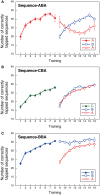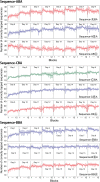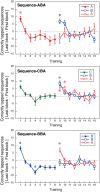Consolidated learning can be susceptible to gradually-developing interference in prolonged motor learning
- PMID: 23755008
- PMCID: PMC3664764
- DOI: 10.3389/fncom.2013.00069
Consolidated learning can be susceptible to gradually-developing interference in prolonged motor learning
Abstract
When multiple items are learned in sequential order, learning for one item tends to be disrupted by subsequently learned items. Such retrograde interference has been studied with paradigms conducted over a relatively short term. Resistance to interference is generally believed to be a measure of learning or consolidation. Here, we used a finger-tapping motor sequence paradigm to examine interference in prolonged motor learning. Three groups of nine subjects participated in training sessions for 16 days, and practiced three different sequences in different orders and combinations. We found that a well-trained motor sequence was subject to a gradual interference when the subsequent learning was paired in a particular order. The results suggest that a well-learned motor memory is still susceptible to interference, and that resistance to interference in one condition does not necessarily imply full, permanent consolidation.
Keywords: consolidation; finger tapping; interference; motor learning; retrograde interference.
Figures






Similar articles
-
Sleep and memory consolidation: motor performance and proactive interference effects in sequence learning.Brain Cogn. 2015 Apr;95:54-61. doi: 10.1016/j.bandc.2015.01.011. Epub 2015 Feb 14. Brain Cogn. 2015. PMID: 25682352
-
Susceptibility of consolidated procedural memory to interference is independent of its active task-based retrieval.PLoS One. 2019 Jan 17;14(1):e0210876. doi: 10.1371/journal.pone.0210876. eCollection 2019. PLoS One. 2019. PMID: 30653576 Free PMC article.
-
Motor memory consolidation processes in young female adults with ADHD may be less susceptible to interference.Neurosci Lett. 2017 Jan 10;637:91-95. doi: 10.1016/j.neulet.2016.11.044. Epub 2016 Nov 22. Neurosci Lett. 2017. PMID: 27888044
-
Learning of a sequential motor skill comprises explicit and implicit components that consolidate differently.J Neurophysiol. 2009 May;101(5):2218-29. doi: 10.1152/jn.01138.2007. Epub 2008 Dec 10. J Neurophysiol. 2009. PMID: 19073794 Free PMC article.
-
Serial practice impairs motor skill consolidation.Exp Brain Res. 2017 Sep;235(9):2601-2613. doi: 10.1007/s00221-017-4992-6. Epub 2017 Jun 1. Exp Brain Res. 2017. PMID: 28573308
Cited by
-
Recent insights into perceptual and motor skill learning.Front Hum Neurosci. 2014 Sep 3;8:683. doi: 10.3389/fnhum.2014.00683. eCollection 2014. Front Hum Neurosci. 2014. PMID: 25232311 Free PMC article. No abstract available.
-
Early sleep after action observation and motor imagery training boosts improvements in manual dexterity.Sci Rep. 2023 Feb 14;13(1):2609. doi: 10.1038/s41598-023-29820-5. Sci Rep. 2023. PMID: 36788349 Free PMC article. Clinical Trial.
-
Configuration perceptual learning and its relationship with element perceptual learning.J Vis. 2022 Dec 1;22(13):2. doi: 10.1167/jov.22.13.2. J Vis. 2022. PMID: 36454549 Free PMC article.
-
Sleep improves accuracy, but not speed, of generalized motor learning in young and older adults and in individuals with Parkinson's disease.Front Behav Neurosci. 2024 Sep 26;18:1466696. doi: 10.3389/fnbeh.2024.1466696. eCollection 2024. Front Behav Neurosci. 2024. PMID: 39390986 Free PMC article.
-
Anterograde interference emerges along a gradient as a function of task similarity: A behavioural study.Eur J Neurosci. 2022 Jan;55(1):49-66. doi: 10.1111/ejn.15561. Epub 2021 Dec 20. Eur J Neurosci. 2022. PMID: 34894023 Free PMC article.
References
Grants and funding
LinkOut - more resources
Full Text Sources
Other Literature Sources

